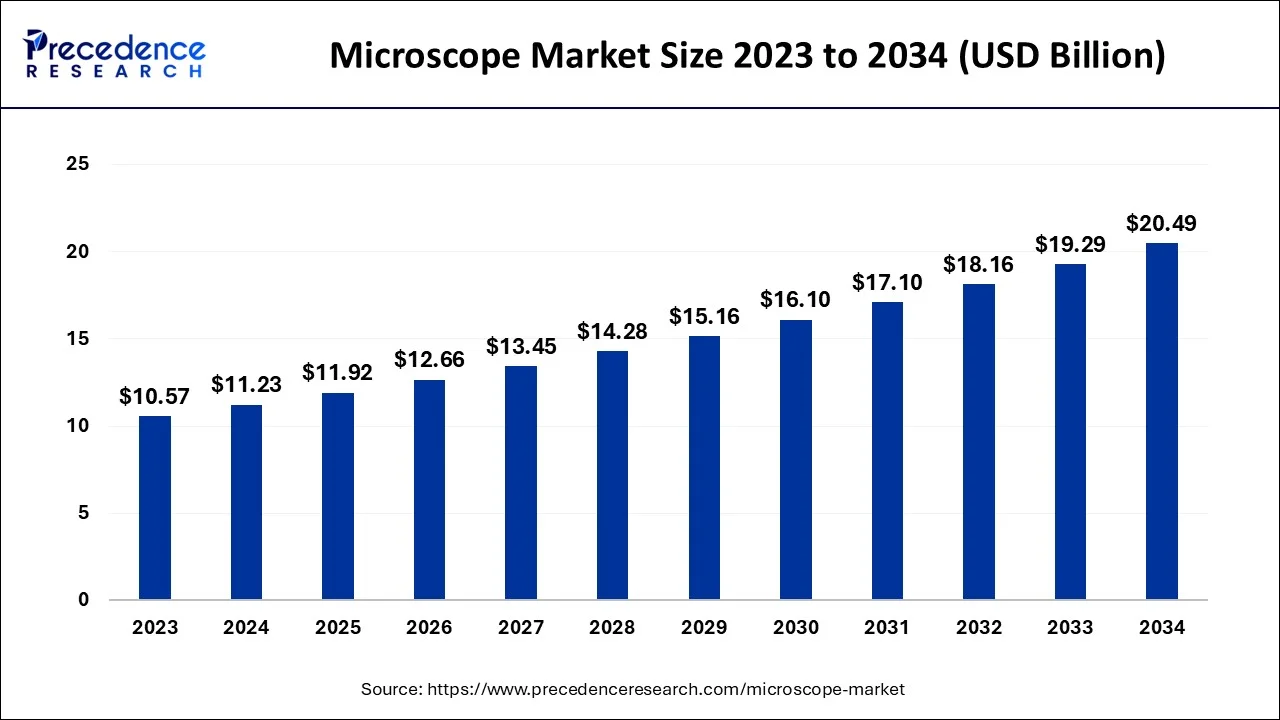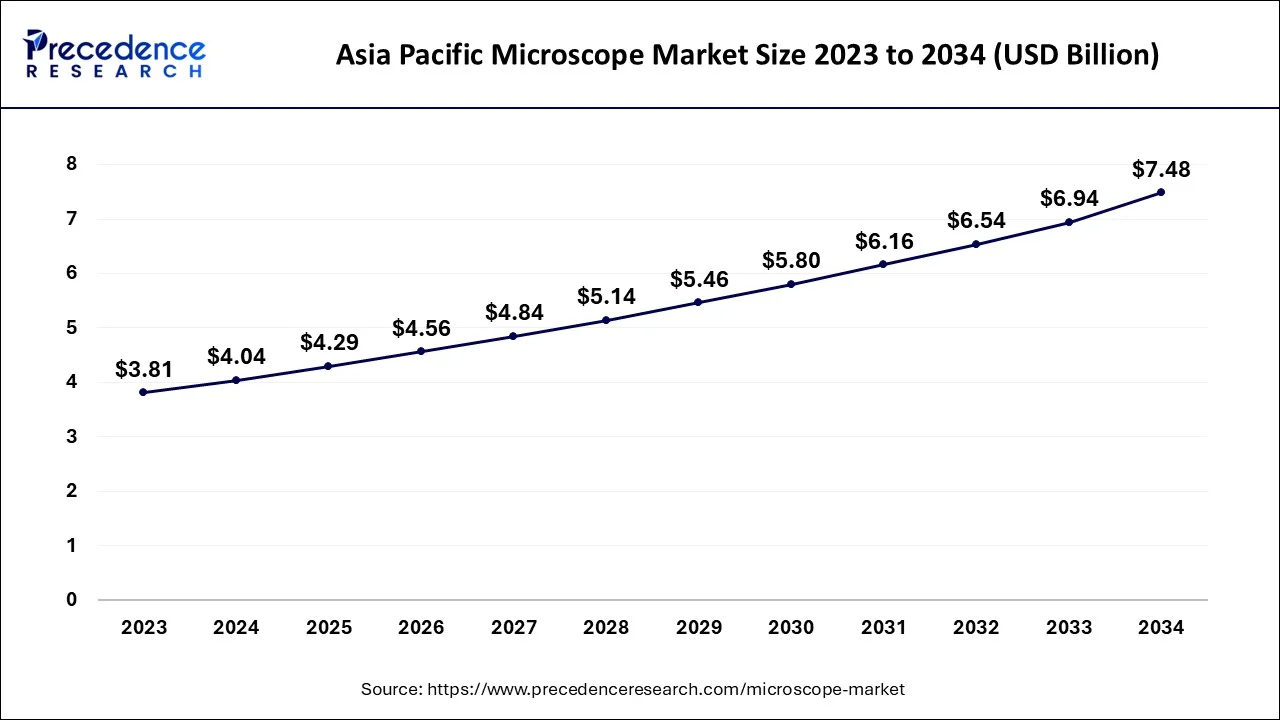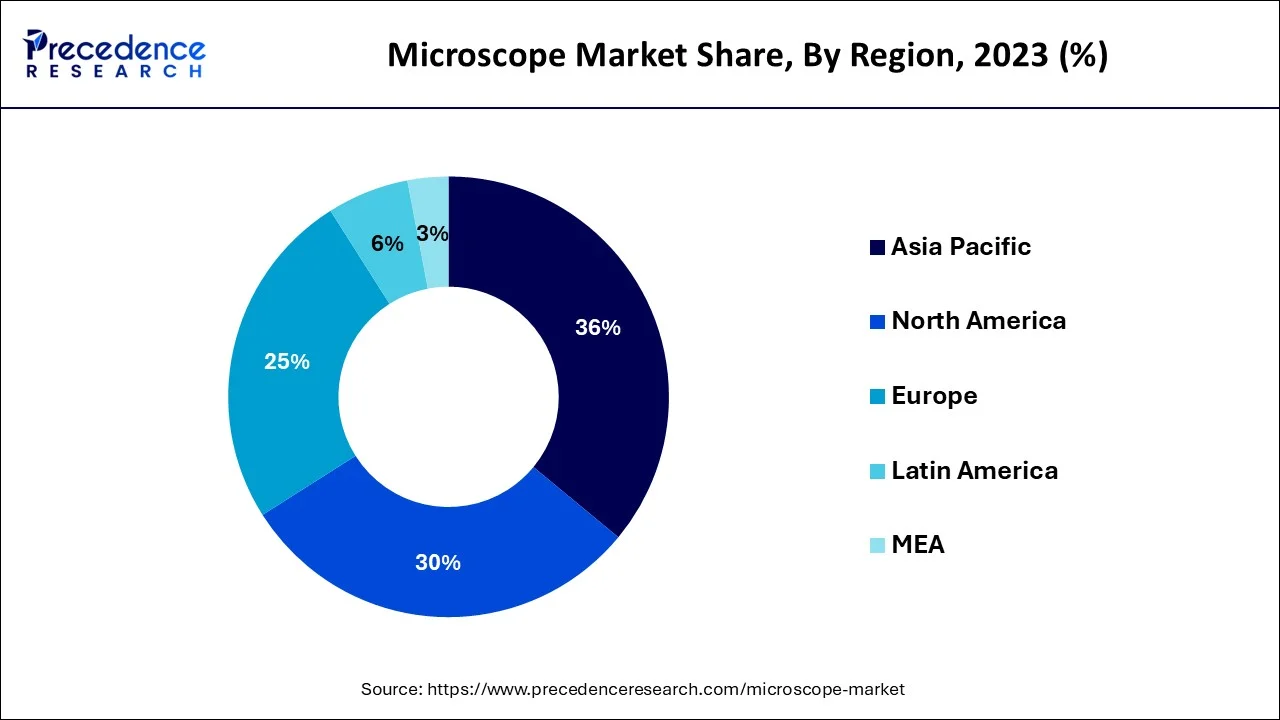The global microscope market size accounted for USD 11.23 billion in 2024, grew to USD 11.92 billion in 2025 and is projected to surpass around USD 20.49 billion by 2034, representing a healthy CAGR of 6.20% between 2024 and 2034.
The global microscope market size is estimated at USD 11.23 billion in 2024 and is anticipated to reach around USD 20.49 billion by 2034, expanding at a CAGR of 6.20% between 2024 and 2034.

The Asia Pacific microscope market size reached USD 4.04 billion in 2024 and is predicted to be worth around USD 7.48 billion by 2034, growing at a CAGR of 6.35% between 2024 to 2034.

Based on the region, the Asia Pacific segment garnered a revenue share of 36% in 2022. This is attributable to the significant increase in research and development activity. Furthermore, improvements in the healthcare industry have resulted into the development of new technologies and medical equipment, which are expected to drive the microscope market in North America even further. Furthermore, the existence of top and prominent companies, as well as early access to new and innovative technologies, is projected to propel North America microscope market during the forecast period.

On the other hand, the North America is estimated to be the most opportunistic segment during the forecast period. This is attributed to the rise in investments by government for the development of medical and healthcare technologies in developing countries such as India, South Korea, and China.
A microscope is a device that magnifies a small object, showing details that would otherwise be invisible to the naked eye. The optical microscope, which employs visible light focused through lenses, is the most common type of microscope.
A significant trend influencing the global market is the increasing integration of microscopes with high-end technologies such as 3D printing and automation. This is expected to increase microscope utilization in a variety of new industries. The miniature transistor devices, quantum dots, and nanotechnology are among of the most well-known applications of microscopes.
Governments in developing countries are investing heavily in modernizing healthcare infrastructure in their individual countries, which is expected to expand healthcare access. The demand for microscopes is likely to increase as a result of this.
The microscope market is benefiting from the significant growth of the food and beverage industry. The microscopes are commonly used in the food analysis to identify unwanted substances such as heavy metals, mycotoxins, and prohibited substances. As a result, the microscope market is growing due to increased restrictions and the implementation of numerous stringent government policies to protect food from toxic substances.
Furthermore, the growing need to extend the shelf life of food and beverage goods is focusing more attention on food microstructures for analyzing texture, flavor, quality, and food features. This is also boosting the usage of microscopes in the food and beverage industry, which is boosting the growth of microscope market during the forecast period.
The increased demand for electron microscope in semiconductors and microelectronics, adoption of electron microscopy in the field of healthcare and life science, and the increasing demand due to developments in electron microscope are all significant factors influencing the global microscope market growth.
The market growth of microscope is hampered by the high initial expenditure, which is a barrier to the adoption in small and medium sized enterprises (SMEs). The increased research and development (R&D) activities in the automotive sector, on the other hand, are likely to provide a profitable potential for the microscope market to grow and develop during the forecast period.
The growing application and scope of electron microscopic devices are propelling the market growth of microscopes. Because of the significant demand from the healthcare business and the ever-expanding semiconductor industry, the microscope market is likely to rise. Furthermore, the advancement of microscope as a tool for supporting research operations is contributing to increased product demand in the market.
| Report Coverage | Details |
| Market Size in 2024 | USD 11.23 billion |
| Market Size in 2034 | USD 10.57 billion |
| Growth Rate | CAGR of 6.20% |
| Largest Market | Asia Pacific |
| Base Year | 2023 |
| Forecast Period | 2024 to 2034 |
| Segments Covered | Type, End Use, and Region |
| Regions Covered | North America, Europe, Asia-Pacific, Latin America and Middle East & Africa |
Based on the type, the scanning electron microscope segment dominated the global microscope market in 2022, in terms of revenue and is estimated to sustain its dominance during the forecast period. The growing demand for nanotechnology-based research, as well as increased financing, are key drivers of the segment. Furthermore, the segment is likely to be driven by increasing product applications in the pharmaceutical and electronics industries during the forecast period. The improvements in the resolution power, as well as features such as the attachment of other devices are likely to drive market expansion throughout the forecast period.
On the other hand, the focused ion beam segment is estimated to be the most opportunistic segment during the forecast period.The increased need for failure analysis in the semiconductor and electronics industries, as well as increased demand for ion beam lithography using focused ion beam systems for creating patterns over the surface of samples, are driving the growth of the segment.
Based on the end use, the healthcare segment held revenue share of over 35% in 2022. The instruments used in life sciences research include compound microscopes, laser microscopes, dissection microscopes, and digital microscopes. The high-magnification microscopes, such as atomic force and electron microscopy, are increasingly being used to examine the genetic architecture of bacteria and viruses.
On the other hand, the food processing segment is estimated to be the most opportunistic segment during the forecast period. The use of microscope in food processing industry has increased over the period of time. This is attributed towards the growing concerns for food safety and norms against adulteration of food. With the help of microscopes, the food processing companies can process food without any additives.
With the presence of several companies, the global microscope market is moderately fragmented. The key market players are attempting to increase their market share by implementing various marketing strategies such as new product launches, investments, partnerships, and mergers and acquisitions. Companies are also investing in product development. Furthermore, they are emphasizing competitive pricing. Various development strategies, such as business expansion and joint venturepromote market growth and provide lucrative growth opportunities to market players.
Segments Covered in the Report
By Type
By End Use
By Geography
For inquiries regarding discounts, bulk purchases, or customization requests, please contact us at sales@precedenceresearch.com
No cookie-cutter, only authentic analysis – take the 1st step to become a Precedence Research client